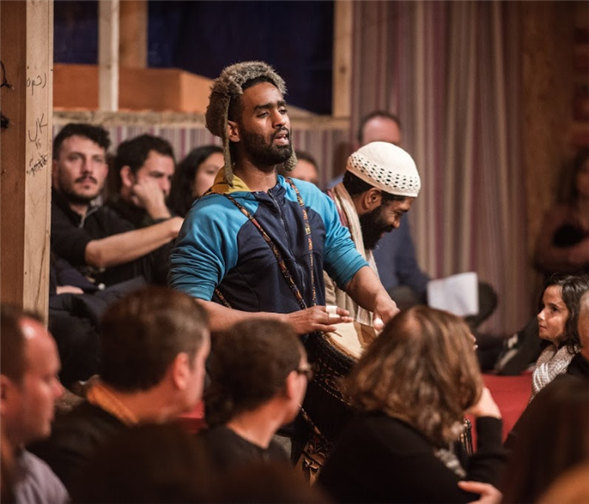Translate Page

How The Jungle recreates life in a migrant camp
---
"When does a place become home?" asks one of the displaced characters in The Jungle, currently at St. Ann's Warehouse in Brooklyn. It's also the central question of Joe Robertson and Joe Murphy's play about refugees from multiple countries scraping by in a real-life camp in Calais, France nicknamed the Jungle. For Robertson and Murphy -- affectionately called "the Joes" by the cast -- the Jungle was the British playwrights' temporary home from September 2015 to March 2016 as they created Good Chance Theatre, where refugees could participate in the performing arts.
"After spending the first week in the camp, we realized that people were telling stories to each other to assess the experiences that they'd gone through, which were so extreme in so many cases," says Murphy. "So we decided to make a place that allowed the stories to be told." With the help of volunteers and donated materials, they erected a geodesic dome that became the cultural center and heartbeat of the camp. Remarkably, that very dome is now at St. Ann's, serving as the entryway into the theatre, which has been transformed into an immersive Afghan café for the production.
Although The Jungle is inspired by the tales the Joes heard at the camp, Murphy says it's not a docudrama -- "it's too intangible to pin down that way." Instead, the impact several major events had on the camp's residents became the bones of the narrative: the devastating photograph of the body of Alan Kurdi, a 3-year old Syrian refugee who drowned in the Mediterranean Sea; the terrorist attack on Paris' Bataclan theatre, which was erroneously blamed on refugees; and the eventual forced eviction and demolition of the Jungle. These incidents -- which are reflected in news coverage broadcast on screens -- serve as gut checks for the characters and what they're up against as they fight to maintain their hope and humanity.
A few ensemble members actually reenact parts of their own refugee stories in The Jungle, including Milan Ghobsheh, an Iranian guitarist who met the Joes at the camp. He was stopped at the Serbian border when a guard noticed his instrument and said if Ghobsheh was any good, he could pass through. The song he plays in The Jungle earned Ghobsheh and 200 others passage through Serbia.
Take that story and multiply it by 7,307, Help Refugees' estimate of the Jungle's peak population. "The news reports, by necessity, were quite limited in their scope," Murphy says. "We didn't have any sense of the personalities of the people behind these labels like 'refugee' or 'migrant.'" Robertson and Murphy wanted their work in the camp -- and ultimately, in The Jungle, which originally ran at London's Young Vic Theater before transferring to the West End -- to celebrate these resilient individuals, who managed to build a makeshift multicultural community under dreadful circumstances.
At the outset of their initiative, the Joes had their doubters. "People would ask us, 'A theater in a refugee camp? Are you kidding? That's the last thing that people need,'" Murphy recalls. But almost immediately they saw how much it benefited the camp's inhabitants. "People would spend all day in lines for food, for clothes, for houses, all the things that you need to survive. But in doing so, they were reduced to a very basic level of existence. If you don't have self-expression, you will only ever be viewed as a refugee. Fundamentally, a refugee is first and foremost a person, and if you are able to express yourself, you are able to be that person, to find your identity."
Robertson and Murphy's own camp experiences are conveyed through the British volunteer characters, who are accused of virtue signaling -- only helping to bolster their egos -- by the French authorities and the refugees. While Murphy understands that criticism, he believes it's often used as a tactic to discourage people from advocating for a cause. "So does that mean that we don't try?" he asks. "I know my answer to that question: We've got to try. And that's what we and, hopefully, more and more people will be doing as a result of seeing this play."
Watching The Jungle here in New York City, theatregoers will inevitably think of what's happening at the U.S.-Mexico border. That parallel is further underscored by the exhibit "When Does a Place Become Home?" in St. Ann's lobby, which juxtaposes photos from the Jungle alongside pictures of Central American refugees, showcasing their shared struggle, trauma and, most importantly, humanity. The combined effect is incredibly powerful.
"Audiences appreciate being able to see behind the news reports," says Murphy. "They appreciate being able to look people in the eye -- people who've been through these experiences -- and just being able to listen."
To read about a student's experience at The Jungle, check out this post on TDF's sister site SEEN.
---
Jen Gushue is a freelance theatre writer with bylines in American Theatre, HowlRound and Business Insider. Follow her on Twitter at @jengushue. Follow TDF at @TDFNYC.
Top image: Mohamed Sarrar (drumming), Jonathan Nyati (in white cap) and Vera Gurpinar (little girl) in The Jungle. Photos by Teddy Wolff.
TDF MEMBERS: Go here to browse our latest discounts for dance, theatre and concerts.